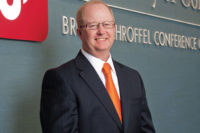It’s a balancing act. It’s always been.
But today, it takes more understanding and sensitivity, more training and supervision.
It’s the business of guarding as well as the relationship between enterprise security leaders and their contract officer firms.
It’s also a matter of family to James Tobin. “Look for a security company that takes care of its employees, part of their family and now part of my family.”
Enterprise security leaders know the importance of that “family” relationship: Strong management, leadership, solid oversight, good training, good officers who have a sense of ownership of the assignment.
Vincent O’Neill knows, too. “There are higher expectations. And cost is not the deciding factor.”
There are about 1,033,000 security officers employed these days, according to the U.S. Department of Labor. California, New York, Texas, Florida and Illinois have the most employed officers. The best paid? In the District of Columbia, Alaska, Washington, Maryland and Virginia.
Emphasis on Quality
There are thousands of security officer firms, but the fewer international, national and large regional firms employ a significant number of officers and often work with the largest enterprises and government agencies. And they set the bar higher when it comes to pre-employment checks, training, supervision, customer service and integration with technology, says Steve Amitay, executive director at the National Association of Security Companies (NASCO), the trade group representing some of the largest security officer firms.
Part of this article is the 10th Annual Top Guarding Firms Listing that has been collected by Securitymagazine and The Security Letter.
One take-away from the Securitymagazine survey of firms is about that balancing act. The challenge is “continuing to recruit and retain the best possible public safety officers while maintaining competitive levels of compensation in spite of cost cutting efforts on all fronts,” says Mert Price of Valor Security.
Relative to cost, “we have gone back 10 years in reference to pricing,” suggests Tamara Martin of the Anderson Security Agency. Eric Crabb of ABM Security agrees: “The compression of margin felt throughout the industry has been the biggest challenge along with the increases in unemployment taxes.” He and others surveyed also are concerned about the impact and implementation of the Affordable Care Act, too.
Total Cost of Ownership
Another challenge “is to encourage organizations to review their total cost of security ownership on an integrated basis, not on an individual service line basis, adds Lew Pincus of G4S Secure Solutions USA.
For O’Neill, that integrated approach means his provider, AlliedBarton Security Services, “takes the effort to understand what I need,” often beyond officers.
One example, AlliedBarton helped successfully spearhead an effort that brought the security firm together with practitioners to address the convergence of physical security, business resiliency and risk-based technologies, according to Guy Hassfield, the firm’s vice president of national accounts.
For AlliedBarton client Jeffrey Chisholm, director, enterprise security and preparedness at Deere & Company, there are “common ground” issues but also centralized as well as decentralized security and access control needs. “It’s as much a matter of putting the right people and processes in place,” he says.
Such togetherness is its own force multiplier, says Pierre Trapanese, president of security integrator Northland Controls Systems. “For operational needs, there is a tech solution out there and then risk management needs to kick in.”
Whatever the big and little challenges, enterprise security leaders such as O’Neill, chief of security operations at the International Monetary Fund (IMF) in Washington, D.C., demands a security officer service that “takes it to an exceptional level.” He believes that one quality measurement is “the management team they put forward” as well as a clear understanding of his procedures and policies. His service provider is AlliedBarton Security Services.
James Tobin, security manager at Lawnwood Regional Medical Center and Heart Institute, Fort Pierce, Fla., within the HCA Healthcare family, wants and has security officers who enjoy coming to work. And they have a diversity of work to do: providing a welcoming, caring environment, controlling access, handling sometimes emotional situations, patrolling the facility – all while striking that essential balance of security and helpful customer service.
When it comes to his security service, Tobin measures things in terms of quality. “A good training program; quality of the officers, many former police officers or from military backgrounds; quality supervision; visible work ethics; and solid, quick response” from the security firm, when needed. So the relationship with G4S Secure Solutions USA is strong, trusting and sharing. “We both want what is best for the hospital.”
The security operation also blends technology with its officers. “We have panic alarms, access controls, security video, emergency telephones, among other deterrents,” says Tobin. And then there is Vonto. “It’s our security dog. We first thought it made sense for outdoor patrolling. But then we moved inside where Vonto is a visible deterrent as well as, uniquely, a comfort to patients, visitors and staff alike.”
There are two essential missions of his security officers, as O’Neill sees it. “Protection and customer service. Every quarter we evaluate according to key performance indicators including customer service testing.” Turnover can be a security officer firm concern, but, according to the IMF executive, “positive turnover can be helpful” when it applies to “identifying your best people” and keeping them. “There is extensive, ongoing training, OSHA needs, customer service training and magnetometer training.”
A Trusting Relationship
Security officers are the first people who arrive at a site of concern. They also are greeters, must be computer literate, on the alert for the potential of theft and workplace violence and for gate operations, for instance, when there is a need for inspection of vehicles. For such critical multi-tasking, “you get what you pay for” when considering pricing of the service.
David Cullen, president, ISI - Intelligence Security International, agrees when it comes to pricing of security officer services. “Of course, you can drive the price down but, at some time, you hit a point of diminishing returns,” says Cullen, who has had proprietary, contract and hybrid officer management experience.
“Hiring practices, how they screen, training – They are all important. But here is a tip: Determine where their closest office is to your site. The closer the better. And conduct a surprise visit to look over their records and support mechanisms. You will more easily see if their resources are stretched,” Cullen advises.
When viewing the big picture, NASCO’s Amitay reports there continues to be significant growth in the sector. “Increased security awareness, homeland security, access control: there are numerous factors” driving the need for security officers. “There are even some traditional law enforcement jobs being filled by private security.”
There continues to be consolidations among security officer and investigation firms as reflected in the Securitymagazine/Security Letter listings. “But we believe that the larger firms have the resources, experience, coverage, willingness and desire” to do the best job for enterprise security leaders, contends Amitay.
His association has a keen eye on ever-improving the industry overall.
For example, early last year, NASCO endorsed H.R. 4112, the Private Security Officer Screening Improvement Act (PSOSIA) introduced by U.S. Congressman Thomas Marino (R-Pennsylvania). The PSOSIA amends the Private Security Officer Employment Authorization Act (PSOEAA) to allow Department of Justice authorized “screening entities” to conduct FBI checks on private security officers, as provided for in the PSOEAA, for authorized employers when such checks are not available from the state of employment.
In addition, it endorsed the Suspicious Activity Reporting (SAR) Training Video for private sector security personnel, published by the joint Department of Justice/Department of Homeland Security Nationwide Suspicious Activity Reporting Initiative. Developed with input from private sector security organizations including NASCO and its member companies, the SAR Training Video for Private Sector Security is designed to expand the nation’s capability to prevent terrorist activity by increasing the number of “eyes and ears” looking for suspicious activity, having those eyes and ears trained properly to distinguish activity that should be reported, and trained on how to report such activity to the appropriate authorities. This training will help private security officers identify and provide the suspicious activity information to law enforcement and counter-terrorism agencies they need to “connect the dots” and prevent future terrorist attacks.
Public-Private Cooperation
Outside of Washington, D.C., there is a growing respect for private security officers, especially by chiefs of police and sheriffs.
One example: Bill McCarthy, Polk County, Iowa, Sheriff, says, “There is a lot more personnel in the security business [when compared to sworn officers]. They cover a wide range of responsibilities and play a great role in our nation.” Among the firms McCarthy interacts with is The Conley Group of Des Moines – a company the sheriff observes as having "high level professionals.”
“Don’t forget that security officers can provide insights and intelligence information. Such information gathering is even more important today,” says McCarthy.
“The foundation of strong and vibrant public-private partnerships is forged out of mutual trust, respect and based on a platform of competency at all levels within the respective organizations,” says Tom Conley, president and CEO of The Conley Group. “Due to nationwide law enforcement standards and core competencies, private security partners need not be concerned about the professional competency level of their law enforcement partners.” He warns, however, “since there are no bona fide nationwide standards and core competencies for private security personnel, competency concerns about private security personnel exist within the law enforcement community. From the private security side, it is not enough for security managers only to be competent. Rather, all security personnel at all levels must be professionally competent in order for public-private partnerships to be built and sustained.”
Ohio Considers State-wide Training
Among recent actions related to the quality of private security officer services, the State of Ohio’s Training Committee of Private Investigation and Security Services Commission is considering the possibility of mandating training for its state-licensed security personnel.
The International Foundation for Protection Officers (IFPO), among others, is helping spur on the Ohio effort.
Conley shares in support of the effort, too. “This is where the certification programs provided by the IFPO fill a need that frankly no other programs are capable of fulfilling. We have used the IFPO’s Certified Protection Officer (CPO) certification for nearly 20 years. As it was 20 years ago and is still the case today, there is no other security officer training or certification program that comes close to matching the CPO certifications or other IFPO certifications. We use the IFPO certification programs because they are the best, are cost-effective, are easy to administer and use. The IFPO certification programs are all widely-respected and professionally recognized not only within the security industry, but also by the law enforcement community and the courts,” Conley points out.
This aticle was previously published in the print magazine as "Security Officer Success: Define Expectations Up Front."
SECURITY’s Top Guarding Firms Listing 2013
What are the top security officer companies? We did the legwork for you – measure the firms by revenue, employees and offices, from Security magazine and The Security Letter.
How Private Security Is Driving Down Crime
Contributed by Robert McCrie, professor of security management at John Jay College of Criminal Justice
and publisher of The Security Letter
A disturbed 20-year-old shoots his mother fatally, then heads off to an elementary school and massacres 20 young kids and six adults before ending his own life. One week later in the next state, a man released from prison for having killed his grandmother with a hammer sets his own car and house on fire and positions himself to assassinate two first responders and injure two others before committing suicide. These brutal recent criminal scenes are etched on the public’s consciousness.
Yet, hard as it is for many to grasp, our society is becoming progressively safer. Private security has much to do with that development. These are two separate assertions. Let’s examine the first one: lower criminality is a reality.
• The FBI’s Uniform Crime Reports (UCRs)tabulate serious reported crime derived from as many as 14,000 law enforcement agencies. Twice a year findings are posted. Since 1991, total serious crimes have declined – and how! Almost every sector of the nation has seen substantively lower crime in the past generation. Adjusting for population growth over the years, UCRshave plunged from 5,898 incidents per 100,000 population in 1991, to 3,295 in 2011. That’s a remarkable 44 percent drop in two decades.
• Another measurement looks at the crime differently. The Department of Justice’s National Crime Victimization Survey (NCVS)asks statistically selected participants to keep a diary of all criminal incidents in their households. This self-report measurement began in 1973 and is projected to a national estimate of major and minor crime, excluding homicide. In its most recent release, NCVSwas up from the previous year, but still near the lowest point in its history.
• Bank crime continues to drift lower. The number of incidents drop while bank branches and stand-alone ATMs rise in numbers. In 1991, robbery of all banks totaled 9,381. In 2011, the total was 5,014, down 46.5 percent in two decades.
• Retail crime is lower. Retail shrinkage is still a $34.5 billion a year loss issue. But the National Retail Survey conducted by Richard Hollinger and colleagues at the University of Florida, Tallahassee, show a significant decline trend. In 1991, the shrinkage rate was 1.79 percent for all retail categories. In 2012, it eased to 1.41 percent. That’s billions retailers and customers have saved from less employee dishonesty, shoplifting, delivery shortages and human errors.
Now how does private security fit into this?
A few years ago a brash small airline used the ad tagline, “If you’ve got it, flaunt it!” The security industry has a right to gloat over its contribution to those salutary developments. Hardly anybody seems to realize the connection. Security services, technology, products and management strategies all have had so much to do with this magnificent achievement of a safe society.
The specifics to show how security makes a critical difference deserve more space than I have available. I’ll just cite three:
• Access control is much better. Years ago unauthorized people walked almost anywhere without being stopped. A few of them were thieves, vandals or people seeking revenge. Today gates, security officers, television, voice communications, ID and biometric systems, and better protective hardware have made those concentric circles of protection we create stronger than ever. As a result, less crime occurs.
• Alarm systems pay off. Commercial alarm systems are more than 150 years old in America. But do they do any good? Common sense says yes, but research was lacking. Seungmug (Zech) Lee at Western Illinois University, Macomb, while at Rutgers, conducted convincing research demonstrating that residential security alarms measurably decrease incidence of home burglaries. More research is needed; but the initial results substantiate what operators of alarmed premises and their client base presumed for years.
• Police and private security are working together better than ever. This is a safe generalization, although scenarios of failure-to-work-together can still be found. When the two do cooperate, a diffusion of benefits has resulted that leads to safer businesses, institutions and residential areas, as well as mutual respect.
Smarter, better metrics-oriented policing has been a huge factor in the beneficial trend. But other resources are enhancing civil safety. A new year has arrived. Don’t expect editorialists around the nation to grasp the importance of what security services and systems providers and their customers have helped achieve. You deserve to flaunt it: better security is making us all safer.













